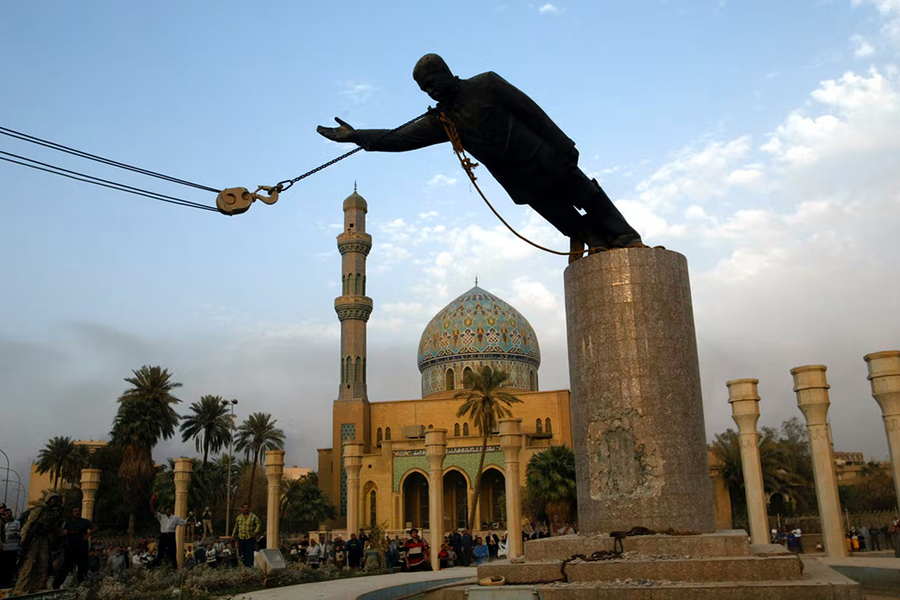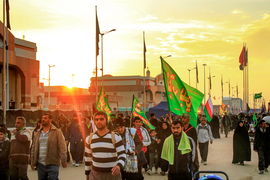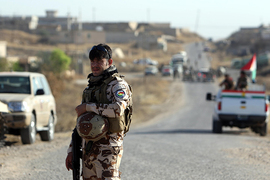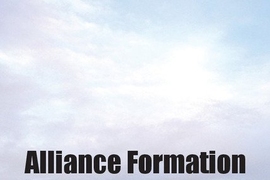Today marks the 20th anniversary of the United States-led invasion of Iraq. Code-named “Operation Iraqi Freedom” by the George W. Bush administration, the goal was to eliminate weapons of mass destruction, topple Saddam Hussein, and remake Iraq into a democracy. Two decades later, U.S. troops are still on Iraqi soil and that nation is ravaged by challenges, including a threat of civil war last August.
To mark the anniversary, Steven Simon, the Robert E Wilhelm Fellow at the MIT Center for International Studies; Peter Krause PhD ’11, an MIT Security Studies Program research affiliate and an associate professor of political science at Boston College; and Marsin Alshamary PhD ’20, an assistant professor at Boston College discuss the history behind the war, lessons learned on state-building, and Iraq’s current political outlook. They, along with Roger Petersen, the Arthur and Ruth Sloan Professor of Political Science, will be speaking at a virtual MIT Starr Forum, The Iraq Invasion: Twenty Years Later, on March 24.
Q: What lessons have political scientists learned from the Iraqi insurgency and the U.S. counterinsurgency campaign?
Peter Krause: One of the first lessons political scientists learned is that that their analysis and predictions can be strikingly accurate, even when their opinions are contrary to those of policymakers and the general public. Although the George W. Bush administration planned and initiated the invasion and a majority of Americans supported it, a majority of political scientists did not. A number of prominent political scientists, including four from MIT, took out a full page ad in The New York Times in September 2002, arguing that the war “[was] not in America’s national interest,” and that such a conflict would “spread instability in the Middle East,” “[increase] anti-Americanism,” “jeopardize the campaign against Al-Qaeda” by diverting resources and attention, and that the U.S. had no plausible exit strategy from Iraq. All of these fears were realized in the subsequent conflict. Although political scientists were unable to do much to impact the decision to go to war, they should take heart that unlike the collapse of the Soviet Union or the Great Recession of 2007-2008, this was a crisis that most saw coming and actively tried to prevent.
The second lesson is that although the U.S. military remains the strongest in the world and has proven its ability to topple regimes, the desire and ability of U.S. policymakers and military leaders to effectively predict and plan for “the day after” a regime falls is lacking. Iraq is unfortunately one of many interventions in the broader Middle East that led to long, seemingly unforeseen insurgencies and individuals leading the new governments that were not who the U.S. predicted or desired.
The third lesson is that although the U.S. government and military may want to learn the first two lessons and subsequently avoid counterinsurgency for the foreseeable future, that is easier said than done. The U.S. can and should be more selective in its interventions, but civil war is by far the most common form of conflict in the modern era. The strength of the U.S. military in any stand-up fight means that resistance to American intervention is likely to take the form of insurgency in the future— especially since adversaries know it is a form of warfare that the American military and public prefer to avoid. In his forthcoming book that explores this topic, Roger Petersen reminds us that “The U.S. cannot simply wish away insurgencies. They are going to occur. The question is what the U.S. and other great powers might do about them.”
Q: What are the major opportunities and challenges facing the Iraqi government?
Steven Simon: The effects of the wars between Iraq and the United States are still playing out. It might be 20 years after G.W. Bush’s invasion of Iraq, but the conflict began in the months of 1991. In the interval, Iraq was the target of a massive air campaign and 12 years of sweeping economic sanctions that killed, impoverished, sickened, and stunted a large part of Iraq’s noncombatant population. This grim period was punctuated by periodic airstrikes.
Combat operations did not really end until ISIS was defeated in 2016. Beginning with Jerry Bremmer’s arrival in Baghdad in 2003, the U.S. dismantled the Iraqi military, undermined Iraq’s residual administrative capacity through de-Baathification, and implanted a consociational political order that normalized corruption and impeded effective governance.
Iraq therefore faces serious challenges. During the past year, Iraqi politics were shaken by an attempt to overturn the apportionment system that has regulated Iraq’s government since shortly after the invasion. The ensuing crisis ended in a violent confrontation and the defeat of the party seeking to overturn the existing system and replace it with a majority government. The irony was that the faction pressing for this transformation was itself the embodiment of the old way of doing business and trusted by no other political faction.
On the positive side, the gunfire and rocket launches that ended the confrontation ended as quickly as it began and did not devolve into an insurgency or civil war. The system was resilient enough to emerge intact from a severe stress test. On the negative side, the system is scarcely appropriate to Iraq’s existing economic difficulties and ability to deliver the range of services on which Iraqi society depends.
Iraq is currently saddled with a hybrid military structure consisting of regular army units and a congeries of mostly Shi’a militias with ties of various intensities to Iran. These irregular units emerged from the ISIS invasion of 2014 and report to the prime minister. The split in the chain of command and divided loyalties of some of these militias is a problem that Iraqis have learned to live with, but could prove more than just awkward if, for example, the U.S. and Iran go to war.
Apart from the U.S. military presence of about 2,500 troops carrying out an advisory and training program and Iran’s support for well-armed militias, Iraq is also burdened by Turkish and Iranian military intervention in Iraqi Kurdistan.
Perhaps the most daunting challenge facing Iraq is climate change. Iraq is already being pummeled by global heating. The southern marshes, an area of habitation and resource extraction, are drying up. Riparian waters are diminishing. The government in Baghdad lacks the capacity to develop and enforce mitigating measures and help is unlikely to come from outside.
The opportunities for Iraq reside in its young population. The question is whether the country’s political economy can secure this cohort an education and job opportunities. In 2019, Iraqi youth erupted in protest against the political system that has failed to provide basic necessities and avenues of advancement. The protests were harshly suppressed by the armed wings of many parties across the spectrum of Iraqi political actors; the system, after all, is essential, among other things, to their ability to maintain patronage networks. Protests have not since broken out but could recur at virtually any time.
Another important opportunity lies in renewed diplomatic and economic ties to the Arab states of the Persian Gulf. Although these wealthy countries have thus far been hesitant to invest in Iraq, emerging links are the necessary precursor to this key component of economic development.
Q: What was the context for the August 2022 protests in Iraq? Why did they turn violent?
Marsin Alshamary: In August 2022, Iraq was once more on the verge of civil war. This time, the conflict was not sectarian as it had been in the 2006-08 war, when Shia and Sunni armed groups fought one another and rearranged the map of Baghdad along religious lines. Rather, this near-civil war would have taken place between different factions belonging to Iraq’s largest and most powerful ethno-religious group, the Shia. In many ways, the transition from inter-group violence to intra-group violence reflected the consolidation of Iraq’s informal power-sharing system of governance.
This near-civil war revolved around a familiar cast of characters. First, there is Muqtada Al-Sadr, notorious amongst American audiences for leading the anti-American insurgency in 2004. Sadr has — like many Iraqi politicians — restyled himself from a militia leader to a politician. His populist messaging resonates with poorer Iraqis and resulted in victories at the ballot box. In the 2018 election, Sadr joined forces with the Iraqi Communist Party and won 54 of the 329 parliamentary seats. In the 2021 early elections, which were held to assuage a wave of anti-government protests, Sadr won 73 seats. In this latest election, the Sadrists were once again the biggest winners, but this time with significantly more seats than the runners-up.
It is not surprising, then, that Sadr saw himself as kingmaker and chose to disrupt the traditional consensus model that Iraq’s politicians had clung to since 2005. He allied himself with the Sunni Taqadum Party and the Kurdistan Democratic Party (KDP) in an attempt to form a government of majority and opposition, rather than consensus.
Sadr’s goal was to force his Shia rivals, the Coordination Framework, into the role of opposition. The Coordination Framework is a group of Shia political parties including former Prime Minister Nouri Al-Maliki’s State of Law, former wartime Prime Minister Haider Al-Abadi’s Alliance of Nation State Forces (in partnership with Ammar Al-Hakim, formerly of the Islamic Supreme Council of Iraq), the Fateh Alliance (consisting of several prominent paramilitary groups from the Popular Mobilization Forces), and smaller parties including current Prime Minister Mohammed Al-Sudani’s Furatain Party.
From the American perspective, the Coordination Framework includes some friendly faces (Haider Al-Abadi and Ammar Al-Hakim) and some whose ties to Iran are worrying (Hadi Al-Ameri and Qais Al-Khazali). Nevertheless, both Iran and the United States largely kept out of the government formation process. At the time, media and analysts largely told a one-dimensional tale of Muqtada Al-Sadr as a reformist and the Coordination Framework as Iranian stooges.
The Sadrists and the Coordination Framework clashed for months, drawing the government formation process for over a year while everyday Iraqis continued to suffer under poor services, security incursions from Turkey and Iran, and the excruciating effects of climate change. The Coordination Framework deployed many tactics to prevent Sadr from forming a majority government, including resorting to the Federal Supreme Court and preventing parliamentary quorums required to elect a president. By June, Sadr grew frustrated at the Coordination Framework and his own allies — Taqadum and the KDP — for their half-hearted investment in a majority government. He ordered his 73 MPs to resign and for his followers to take to the International Zone, a fortified area in central Baghdad that houses government buildings, the U.N. compound, and various foreign missions, including the American Embassy.
For a few weeks, the protests were relatively peaceful but hugely destabilizing for daily affairs. New parliamentarians were sworn in and the numbers for the Coordination Framework swelled. They set about forming a government without Sadr while he called on the Iraqi people to join his protestors to demand a change in government type. Everyday Iraqis — who had in 2019 come out in droves to protest the government — largely stayed out of it, fearing the Sadrists’ known mercurial nature. In 2019, the Sadrists vacillated between supporting the popular protest movement and between turning against it violently. Iraqis have little faith in their political leaders, including Sadr, who often tries to style himself as a man of the people.
The peace did not hold. In late August, Sadr announced his withdrawal from politics and suggested that he would not be responsible for the behavior of his followers. The protests turned violent as the Sadrists and members of the Iraqi Security Forces and Popular Mobilization Forces fought each other in clashes that extended beyond Baghdad. During that restless night, residents of Baghdad were reminded of the civil war. For many observers, it looked as though Iraq was falling into a Shia-Shia civil war. The next day, presumably under pressure from elite Shia clerics and due to a military defeat in the International Zone, Sadr apologized to the Iraqi people and called for his followers to halt the violence. They immediately demobilized.
The tensions with the Sadrists have not dissipated and will lurk in the background of Prime Minister Sudani’s premiership. The context of this violence is different from instances of violence in the past. It is not directed at an occupying force or an ethno-religious enemy. Rather, it is a manifestation of competition among the Shia.










